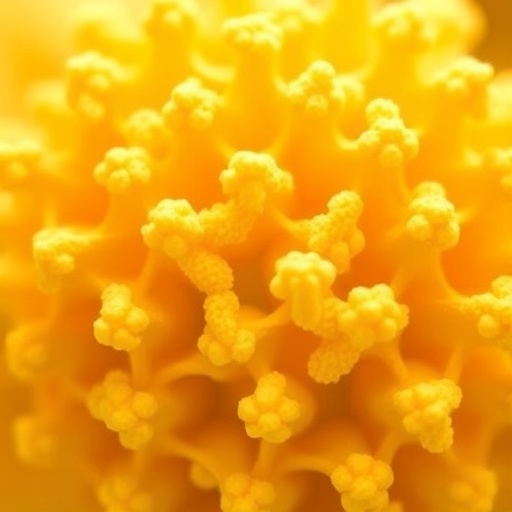A recent breakthrough in microbial biotechnology has unveiled the intricate mechanisms by which Lactococcus lactis, a ubiquitous bacterium found in many fermented foods, modulates the production of a critical precursor molecule essential for the biosynthesis of vitamin K₂, also known as menaquinone. This discovery not only advances our understanding of microbial metabolism but also opens avenues for sustainable and cost-effective vitamin production through bioengineering.
Vitamin K₂ plays a pivotal role in human health, including blood clotting and bone metabolism, making its efficient synthesis a target for nutritional and pharmaceutical industries. Traditionally, vitamin K₂ has been extracted from plants or chemically synthesized, processes that can be resource-intensive and environmentally taxing. The use of microorganisms like L. lactis, which are generally recognized as safe (GRAS), in fermentative production of vitamins holds promise for greener alternatives.
The study concentrated on deciphering how L. lactis precisely regulates intracellular levels of an unstable intermediate metabolite that channels all forms of vitamin K₂ synthesis. This precursor’s regulated balance is crucial: adequate concentration supports cellular growth and metabolic function, while excess accumulation can provoke toxicity due to reactive quinone species. Understanding this balance is paramount for unlocking the bacteria’s vitamin-producing potential beyond its natural capacity.
To tackle the inherent difficulty in detecting such an ephemeral and low-abundance intermediate, the researchers innovated a novel biosensor constructed in a surrogate bacterial host. Unlike conventional biochemical assays requiring sophisticated instrumentation, this biosensor dramatically amplifies precursor detection sensitivity by several orders of magnitude, allowing for real-time, cost-effective monitoring of metabolic fluxes.
Building upon this, the team employed targeted genetic manipulations to modulate the expression levels of enzymes directly involved in the vitamin K₂ biosynthetic pathway. By systematically overexpressing or repressing these genes and monitoring the resultant impact on precursor output, they gathered quantitative data points which were fed into a comprehensive mathematical model. This integrative approach tightly coupled experimental biology with computational prediction.
An initial theoretical model presumed an unlimited supply of precursor substrate, leading to predictions that did not align with empirical observations. Adjusting this model to account for substrate depletion—a phenomenon critical in metabolic networks—yielded output that accurately reflected laboratory results. This refinement highlighted the cellular limitations imposed not only by enzymatic control but also by the availability of metabolic substrates, suggesting a dual regulatory safeguard.
Further analysis revealed that simply overexpressing enzymes in isolation could not surpass the production plateau because the scarcity of precursor molecules bottlenecked the pathway. Analogous to baking more cookies without increasing the amount of flour, enzyme abundance alone was insufficient to drive higher yield. Thus, substrate availability emerges as a fundamental constraint in microbial vitamin biosynthesis.
The spatial arrangement of genes encoding biosynthesis enzymes on the bacterial chromosome also surfaced as a critical factor influencing precursor generation. Gene order modulates transcriptional and translational dynamics, potentially impacting enzyme stoichiometry and pathway efficiency. This genomic architecture underscores an evolutionary layer of regulation ensuring metabolic homeostasis.
Exploring these regulatory layers in unison, the researchers demonstrated that coordinated tuning of substrate provisioning, enzyme expression levels, and gene arrangement can effectively breach the natural production ceiling. This integrative strategy enables unprecedented control over bacterial vitamin biosynthesis, widening the scope for industrial application.
Such insights hold transformative potential for the production of vitamin K₂. By engineering L. lactis or similar food-grade microbial strains to biosynthesize higher vitamin quantities, manufacturers could develop more sustainable fermentation-based processes. This paradigm shift promises to diminish reliance on traditional chemical synthesis or extraction methods, thereby lowering environmental footprint and production costs.
Moreover, augmenting vitamin K₂ biosynthesis in probiotics could yield functional foods with enhanced nutritional benefits. Probiotic formulations containing such engineered strains might offer targeted supplementation within the human gut, effectively bridging microbial metabolism and host health. This convergence of synthetic biology and nutrition embodies the frontier of next-generation therapeutics.
The research received support from prominent funding bodies such as the Cancer Prevention and Research Institute of Texas (CPRIT) and the National Science Foundation, reflecting its dual significance in advancing fundamental science and addressing global health challenges. The collaboration was facilitated through the Rice Synthetic Biology Institute, showcasing interdisciplinary synergy between molecular biology, bioengineering, and computational modeling.
As synthetic biology continues to unravel and reprogram the intricate pathways of microbial metabolism, the fine balance between growth benefits and toxicological risks exemplified by quinone biosynthesis in L. lactis offers a compelling model. Navigating these dualities with precision engineering not only enhances microbial production platforms but also propels the broader endeavor of sustainable biomanufacturing.
This landmark study, published in the journal mBio, highlights how embracing the complexity of regulatory networks within microbes leads to tangible breakthroughs. By pushing production limits through a harmonious blend of biosensing, genetic rewiring, and mathematical modeling, scientists are forging paths toward a new era of vitamin synthesis that is as eco-friendly as it is efficient.
Subject of Research: Regulation of vitamin K₂ biosynthesis precursor production in Lactococcus lactis
Article Title: The growth benefits and toxicity of quinone biosynthesis are balanced by a dual regulatory mechanism and substrate limitations
News Publication Date: 11-Aug-2025
Web References:
https://journals.asm.org/doi/10.1128/mbio.00887-25
Image Credits: Photo by Jeff Fitlow/Rice University.
Keywords: Vitamin K, Biosynthesis, Microorganisms, Chemical synthesis, Genetic engineering, Mathematical modeling, Biosynthetic pathways




